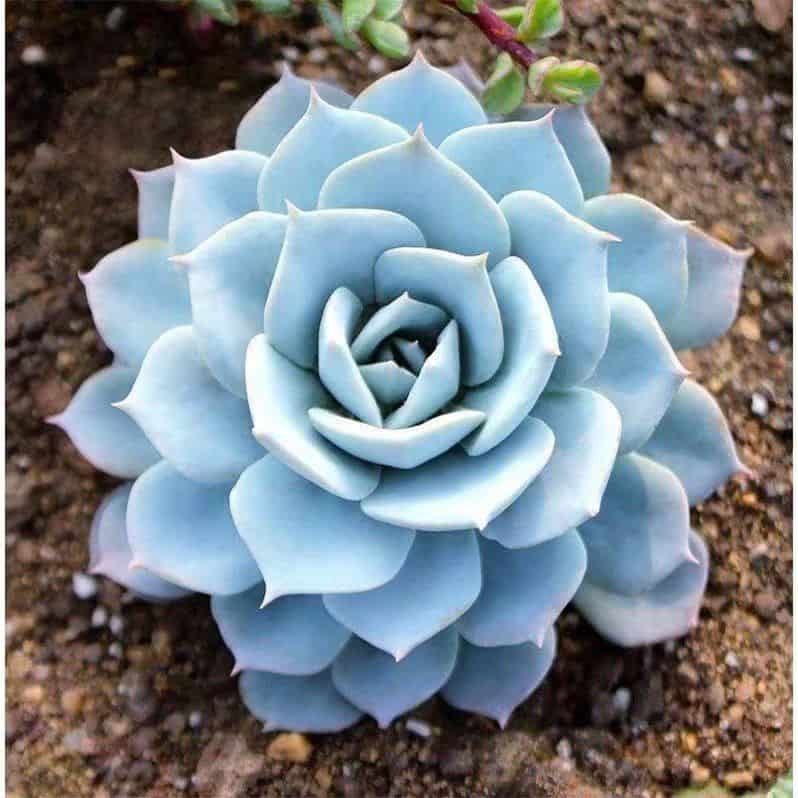A sky-blue, silvery-toned rosette with pinkish outlines that looks ethereal in gardens and pathways, the Echeveria ‘Blue Bird’ will surely capture the eyes of the beholder! Having an iridescent glow on the leaves, Blue Bird succulent can grow around 10 inches in size. The leaves appear to have a coating of white powdery granules caused by epicuticular wax! Moreover, when the plant reaches maturity, you will see orange flowers growing, enhancing its beauty.
The plant is popular for producing pups very often around the stem, which makes it ideal for propagation. We will discuss everything from growing and caring to propagation in this article, so stay tuned and walk with us till the end to enlighten yourself about good practices to grow the Echeveria ‘Blue Bird’!

Caring for the Echeveria ‘Blue Bird’
Like all succulents, this one doesn’t need hours long of care. With minimal effort, you can see that the succulents will start blooming! We will talk about essential things the plant needs to thrive.
Sunlight
A very crucial thing, as you might be aware. The Echeveria ‘Blue Bird’ prefers to stay in full sun in the mornings and partial sun in the afternoon for around 6 hours in the summer months. Partial shade is necessary when the scorching afternoon sun shines blazingly on these beautiful, pearl-like succulents, otherwise, they will be vulnerable to getting sunburned fast.
Similarly, keep the succulent near the windowsill in the winter, so it is easily exposed to sunlight. The winter months are hard for the plant to survive, so make sure it gets adequate sunlight.
Water
The succulent needs water, but not in excessive quantities! Overwatering the plant is like a death call for it. You want the plant to survive and grow healthily, right? Then adapt the ‘ soak and dry ’ method.
This method has to check the soil before watering the plant. If the soil is watery/has moisture, then delay watering the plant until the soil becomes completely dry. Once you feel the soil is deprived of all moisture, water it only in adequate quantities, as overwatering can have extremely harsh effects on the plant!
Soil
Perfect soil would be grainy and porous, so much so that it lets water pass through it easily and doesn’t compact after watering. Moreover, the grainy texture of soils makes it easy for the air to pass through them. Usually, it is discouraged to use only sand as a potting mix because it tends to get compact after watering it several times.
It is also encouraged to keep repotting the plant to prevent soil from getting compact and letting air pass through. Make sure the pot (which you are using for the plant) has a good drainage hole to let water pass through it easily.
Overall, a plant with well-drainage is less susceptible to overwatering symptoms such as yellow leaves and root rots, and the plant looks generally healthy.
Temperature and Humidity
The Echeveria ‘Blue Bird’ is not a frost-hardy plant; as mentioned above, it prefers to stay in bright sunlight. This summer-loving succulent doesn’t live well in areas that have temperatures below 10 degrees Celsius. In low temperatures, the plant is vulnerable to frost bites as it has a tolerance toward cold temperatures.
In summers, the plant can live well in areas having temperatures around 25 degrees Celsius.
As for humidity levels, the plant can live well in areas having 40 % to 60 % humidity levels. When kept outdoors, the plant will get these humidity levels, but in indoor environments, the plant might not get its desired moisture level. A simple solution to that is sprayed mist to fulfill humidity requirements.
Fertilizer
The plant does pretty well without fertilizers. However, if you feel there is a need to bolster your plant’s growth, apply soluble fertilizers in the growing stage. Make sure the weather isn’t too hot at the time of applying fertilizer. Additionally, avoid over-fertilizing as it can have disastrous effects on the plant, and you don’t want your plant to suffer!

Propagating Echeveria ‘Blue Bird’
It can be propagated using seeds, offsets, and leaves; the method is the same for all. This plant is an ideal plant for propagation due to the high number of offsets that grow on it. Once you find an offset/leaf, cut it with a sharp knife/blade and clean the excess soil. Please wait a few days to re-plant it, as the offset must be callous to get ready for planting. Once it callouses, plant the offset in a good-drainage soil and water it frequently until maturity.
Pests and Plant Diseases
Pests Diseases
Mealy bugs and spider mites are common pest diseases that can be eradicated with isopropyl solution.
Plant Diseases
The Echeveria ‘Blue Bird’ is susceptible to root rots if overwatered. To get rid of them, stop watering the plant for a few days until the roots are back to normal.
Conclusion
So, this was about growing, caring, important elements, potential diseases, and their cures. We hope this guide for helpful and insightful for you to be able to grow an Echeveria ‘Blue Bird’ successfully!




